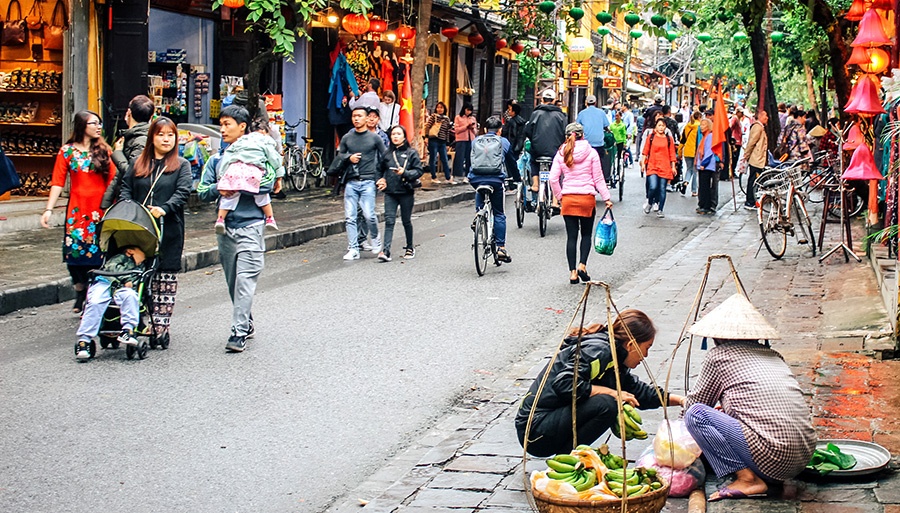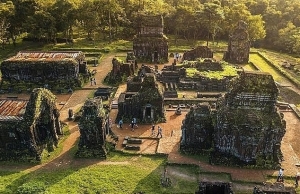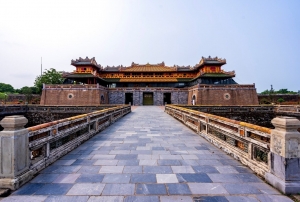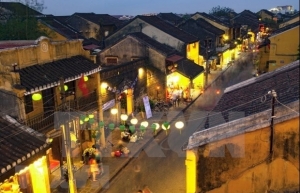New vitality comes to monuments and heritage sites
 |
| New vitality comes to monuments and heritage sites |
A performance combining art installation and projection technology called “Ngoc Son Temple - Mysterious Night” now takes place at Ngoc Son Temple, and is becoming a new highlight for Hanoi’s night tourism.
The temple is one of the most renowned landscapes in the capital, located on Hoan Kiem Lake in the Old Quarter.
According to the Hanoi management board for heritage sites and scenic landscapes, the special programme to explore Ngoc Son Temple at night takes place on Wednesday and Thursday evenings, with each tour under the experimental programme lasting 60 minutes and admitting up to 70 visitors at a time. Ticket prices for each show are currently $11 each.
“The difference of this programme compared to others in Hanoi is the combination of the ancient architecture of Ngoc Son Temple relics and the rituals and folk legends that have been passed down. We expect it will convey to visitors traditional Vietnamese cultural values in a new way,” said a representative of the management board.
Night tours are becoming more popular in Hanoi. Last year, the capital launched 15 night tourism products, almost half of which are tours to explore historical relics in the evenings. These include night tours at the Temple of Literature, Thang Long Imperial Citadel, Thang Long water puppet show, and Hoa Lo Prison.
Dang Huong Giang, director of the Hanoi Tourism Department, said, “Combining modern technology with Hanoi’s cultural and historical space at night is a factor to entice tourists and make a difference. We set a target of attracting 25.5 million tourists to Hanoi this year, including five million foreign visitors. Total tourism turnover is expected to reach $4 billion.”
Hanoi currently possesses rich tourism resources, with nearly 6,000 historical and cultural relics and almsot 1,800 intangible cultural heritages.
Other destinations in Vietnam are also looking for ways to update heritage and tourist relics.
For example, the Centre for Historical Relic Preservation for Hoa Lu in the northern province of Ninh Binh has applied IT, digital transformation, and digitisation of heritages.
To display and promote the value of relics to tourists, the centre has put into use a 3D perspective projection system in the exhibition area to introduce historical and cultural relics of the ancient capital.
The sacred and ancient space, combined with modern technology and real-life demonstrations, has brought a new and attractive angle to the destination, replacing the somewhat boring experiences that focus on sightseeing and listening to simple explanations.
In 2019, Hue created an automatic interpretation system using 12 different languages in the Royal Palace area and Nguyen Dynasty mausoleums. The Hue Museum of Royal Antiquities also uses QR codes to support information for visitors.
The Hue Monuments Conservation Centre has so far digitalised over 170 relics, archaeological and heritage records, 25,000 pages of ancient Han-Nom script documents, and nearly 300 photographs of poetry and literature on Hue’s royal architecture. More than 10,000 other antiques and artefacts are being prepared for 3D digitalisation.
Elsewhere, according to Ho Chi Minh City Department of Tourism, Cu Chi Tunnels will also boast a night tour on three separate occasions in March. The tours will take place 6-8.40pm for $16.80 per person, recreating the life of Cu Chi people based in the liberated area during 1961-1964.
In 2022, Ho Chi Minh City also introduced a double-decker bus tour called Sleepless in Saigon, departing from 11pm at Nguyen Hue walking street and passing by nearly 20 monuments, architectural attractions, and culinary neighbourhoods with bustling activities in the city such as Bui Vien, Ben Thanh Market, and Notre Dame Cathedral.
Dang Van Bai, who is vice chairman of the National Heritage Council, said that developing night tourism will help spread cultural heritage values to the masses and generate revenue to support the preservation of cultural heritage.
“Night tours will expand spaces and extend visiting time, creating cultural events and extremely rich experiences,” he said.
Phung Quang Thang, vice chairman of the Vietnam Travel Association, said that with a rich history and culture, Vietnam can organise many different topics at each tourist destination.
“It is important to know how to take advantage of space and technological effects to bring the most authentic experiences to visitors,” Thang said. “It is also important to understand the historical and cultural values of each locality to promote them creatively and effectively.”
According to the Ministry of Culture, Sports, and Tourism, Vietnam currently has 40,000 historical-cultural relics, 70,000 intangible cultural heritages, and eight relics recognised as World Heritage Sites by UNESCO.
 | Two World Heritage sites celebrate 20 years of UNESCO recognition Prime Minister Nguyen Xuan Phuc has praised the central province of Quang Nam for its efforts to preserve the world heritage sites of Hoi An ancient town and My Son Sanctuary in the 20 years since their recognition by the UNESCO. |
 | Hue to expand scope to restore heritage sites and reinforce development From this July, Hue city will be quadrupled to consist of 29 wards and seven communes, to turn it into a centrally-governed city by 2025. |
 | Quang Nam’s world heritage sites welcome foreign visitors Two world heritage sites in the central province of Quang Nam – Hoi An ancient town and My Son Sanctuary – began to welcome foreign tourists starting November 15. |
What the stars mean:
★ Poor ★ ★ Promising ★★★ Good ★★★★ Very good ★★★★★ Exceptional
Related Contents
Latest News
More News
- The destinations powering Vietnam’s festive season travel demand (December 04, 2025 | 18:33)
- Vietnam named among the world’s most exciting winter destinations (December 04, 2025 | 15:10)
- Phu Tho emerges as northern Vietnam’s new tourism hub (December 01, 2025 | 17:00)
- Vietjet completes Airbus A320/A321 updates ahead of deadline (December 01, 2025 | 09:49)
- Vietjet resumes Con Dao flights from early December (November 28, 2025 | 15:24)
- Free tickets, Lunar New Year promotions on offer at Vietjet Mega Livestream (November 26, 2025 | 15:32)
- Scandinavian Airlines and Vietnam Airlines broaden agreement with new routes (November 25, 2025 | 17:04)
- Halong Cruise Port welcomes over 3,100 international visitors (November 12, 2025 | 18:06)
- Vietnam.travel climbs to second place in Southeast Asia website rankings (November 12, 2025 | 18:01)
- Cat Ba named among Southeast Asia’s top island adventures (November 11, 2025 | 18:09)

 Tag:
Tag:



















 Mobile Version
Mobile Version